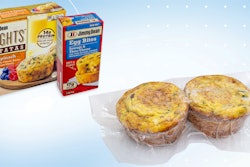Welcome to Package This — your guide to packaging machinery and materials. Today, it’s time to get horizontal, and we don’t mean taking a nap. Now it’s time to take a tour of the world of horizontal form/fill/seal machines.
Like their vertical cousins, which we discussed in another episode, horizontal form/fill/seal machines are a go-to technology for growing brands seeking speed and efficiency on their bagging and pouching lines.
The technology behind all horizontal form/fill seal machines is very similar regardless of the bag type. The machine unwinds a flat, preprinted roll of film known as rollstock over the mandrel, which forms the plastic roll stock into a tube. Product is then filled via an overhead combination weigher or similar product feeder. After product loading, the tube is then heat-sealed, front and back. Finally, the machine cuts the stock to form individual pouches.
Stand-Up Pouches
One common type of bag that runs on HFFS equipment is the stand-up pouch, a popular choice for a variety of dry products, including snacks, candy, and pet food.
In this video from Paxiom, we see how a stand-up pouch is formed on their R2B horizontal form/ fill/seal bagging machine. First, film unwinds to form bags from the roll stock. Then, a machine part called a walking beam captures the formed bag and advances it to the filler. An overhead combination scale, shown here with snacks, measures the precise amount of product and dispenses it through a chute into the awaiting bag.
This machine is designed for high-speed applications up to 60 bags per minute in a 1-up configuration and 200 bags per minute in a 3-up configuration. HFFS systems like this one can help brands save money by producing the bag in-house, reducing material unit costs by an average of 30% as opposed to purchasing pre-made pouches. This unit is compact and does not take up much more floor space than a premade pouch machine.
Flat Pouches
Brands may also opt for flat pouches, which HFFS equipment can also run. Hundreds of products can be packed into flat pouches, including makeup remover cloths and facial masks for the cosmetics industry and pouches of flower seeds. As the name implies, flat pouches are designed to lay flat or be stacked in a carton or in a display case on store shelves.
While many HFFS sealers employ a gusseting unit, which is a small arm that pokes the bag to form flat or rectangular folds or panels, flat pouch machines feature simple seals with no gussets.
Three-Sided Bags
Three-side sealed bags can also be produced on HFFS machines. These bags are commonly used for packaging dried meats, jerky, powders, mixes, and seeds. On a three-sided seal machine, the front and back panels are sealed along three edges. The fourth edge has no hard seal but a fold in the plastic, allowing product to settle at the bottom of the bag effectively.
Many brands choose to enhance these three- and four-sided seal pouches by incorporating reclosable features like zippers and tear notches, which require machine adjustments. Some brands opt to add a hang hole to their three-sided pouch for retail.
Four-Sided Pouches
HFFS machines handle four-sided seal pouches, which are similar to sachets but typically larger. HFFS equipment for four-sided seal pouches make a hard seal on every edge of the package.
Machines can package wet products like pet food and tuna and dry goods like flour and powders can be packed in four-sided seal pouches. Because four-sided seal bags are often placed in cartons or display packaging, these machines might be integrated with cartoners or case packing equipment.
Like other pouch machines, they can be customized to handle packaging features like tear notches and resealable zippers.
We have just skimmed the surface of what horizontal form/fill/seal equipment can do. There are many more machines that can form custom shapes of pouches and add fitments and features like spouts and zippers.
For more videos on packaging machinery and materials, please subscribe to our full Package This series on YouTube.
If you’re looking for companies with HFFS capabilities for these and other applications, explore PMMI ProSource, a searchable directory with 1,000 packaging and processing suppliers. Visit ProSource.org to search suppliers by package type, material, or features.
Thanks for watching!

























